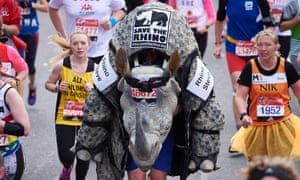The world always looks better after a run. Many people attest that running helps them beat their “black dog” or cope with anxiety, stress and sadness. You feel mentally stronger, more alert, more alive, when the blood is pumping and the endorphins are flowing. The runner’s rush is a real thing. It’s difficult to hate anyone, or the world, or yourself after running 26.2 miles.
It works the other way, too. A calm mind at ease with itself will improve your running. You run and you find an inner peace. The inner peace helps you run more efficiently. The more efficient you are, the more you will run.
But this harmony brings problems. Running becomes an addiction. The day I got married all I could think about was whether I’d be able to get a run in. (Answer: yes, seven miles, Whitstable to Herne Bay and back). I had a similar concern the day my son was born (answer: no, but not for lack of thinking about it).
As with any addiction, you crave ever more powerful kicks. You want to go further and faster. Funerals, weddings, Christmas, holidays, birthdays – I have gone to fiendish lengths to accommodate a run. I once ran up Dead Woman’s Pass in Machu Picchu to get my daily run in. It’s around 4,000 metres above sea level. My lungs still haven’t recovered.
Distance running is one of the very few sports that you can improve on as you get older. Physiological changes to your body mean that you’ll be able to run further than when you were a teenager. Few things are more powerful existentially than vanquishing your youthful self. And then, unless you’re very lucky, an injury strikes and you’re no longer able to run. Suddenly, the world becomes a significantly greater challenge as you contemplate the gaping hole that has opened up in your life. The one constant you had – the daily run – has gone. You become irritable, uncertain of yourself, envious of those able to run, angry at those who could but don’t.
You seek alternative kicks – cycling, swimming, yoga, wine, Netflix box sets; but none brings release. There is no choice but to go cold turkey and pray for the day when you can lace up your trainers and start running again.
Then you notice something is missing. You notice that you are no longer permanently exhausted. Night sweats, sore hamstrings, constant colds, the aching soles, the relentless hunger: all banished. You pledge not to go back there. You’re Renton in Trainspotting. You’re going to get clean. Just one last hit…
So beware this 10-point plan. Come next April, you may be lining up in a strange city with scores of rhinos and a man with a washing machine on his back. And, to quote Talking Heads: “you may ask yourself, how did I get here?”
1. If you can walk, you can run. Just start off doing brisk walks. After a few weeks switch to gentle walking followed by gentle jogging. Don’t push yourself to exhaustion. The emphasis is on time on your feet, not speed. Soon you’ll be able to jog a mile. Then two. And three miles is 5km.
2. Sign up for your local 5k parkrun. It’s free and run by possibly the nicest people in your community. At the end of the run you get your time. Can you do better next week? What about on a different parkrun course? Injured? Maybe volunteer as a marshall one week?
3. You’ve been running for three months now – you’re a proper runner. Invest in decent kit, download a free running app (Strava, Runkeeper) to clock your runs. There are some excellent forums out there crammed with runners keen to share their knowledge. Fetcheveryone is a good place to start.
4. Start mixing things up. Do a little speed work each week. Hills are horrible but will make you a better runner. Fartleks – varying your speed – can be fun. Try to make time for a weekly long run. Run on roads, run on trails, run on grass. Keep things varied.

5. Time to think about a 10km. Run one for charity – raising money for a good cause will spur you on, and you’ll get a charity vest with your name on it to run in. You’ll be astonished at how people will cheer you on. You can run through walls with that level of support.
6. Work on your core. This will help you run strong. Squat thrusts, sit ups, burpies – basically any exercise you’d rather not do – all are good for core strengthening. Pilates and yoga yield benefits, too.
7. Get a foam roller. Buy some bath salts. Eat intelligently. You’re asking a lot of your body. Try to meet it half way.
8. You went for a run on Christmas morning? You’re way through the looking glass now. Perhaps a half marathon would be achievable? There’s some brilliant runs in March. That’s three months away. Start cranking up the long runs.
9. That half marathon was a race of two halves, wasn’t it? First half went OK but the second was miserable. You went off too fast and blew up. Learn lessons, chiefly the need to pace. Next time, save the afterburners for the last three miles.
10. You’ve now got three halves under your belt. Sometimes on your long runs you’re doing 16 miles. You’re edging closer to a marathon. This is the tipping point. Once you’ve completed this, you’re only going to go one way. There’s a race with your name on it out there right now. And when, around mile 22, you cannot contemplate another step, and you want to punch one of the rhinos, or dismantle the washing machine man, remember things could be worse. There are ultramarathons.
Source: Read Full Article
